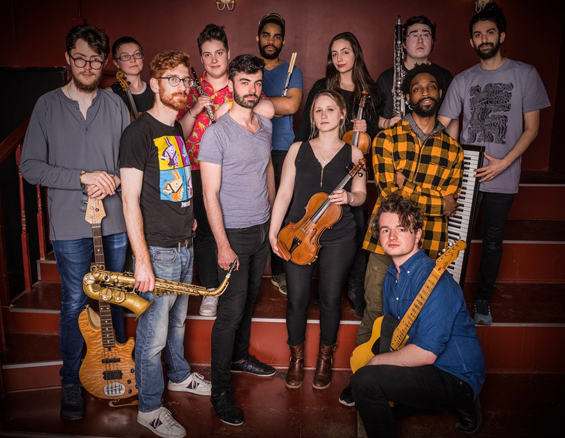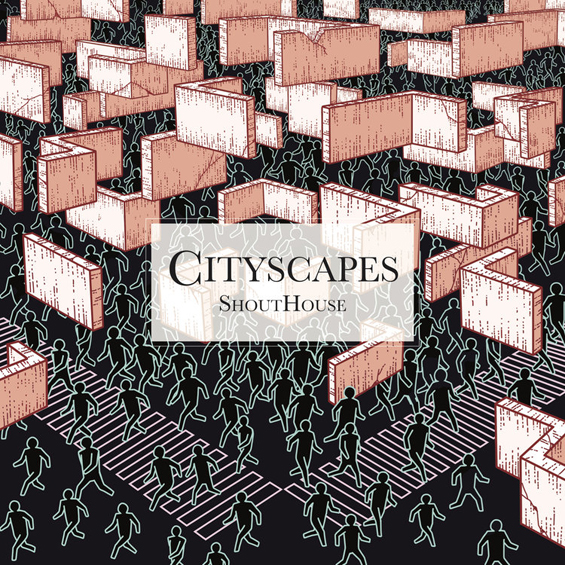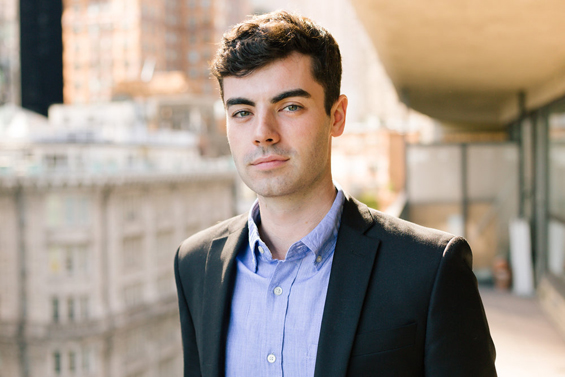

BACKTRACKING WITH SHOUTHOUSE'S CITYSCAPES
Teeming with vitality and bursting with energy, Cityscapes is as boisterous and panoramic as the place it celebrates: New York City. It's also, of course, the place ShoutHouse, the twenty-five members-strong outfit directed by composer Will Healy and whose membership includes four composers, five rappers, three jazz soloists, and more than a dozen classical musicians, calls home. Each track on Cityscapes, the band's debut full-length (available from New Amsterdam as part of its digitally focused Windmill Series), deals with a different time, space, or story in the city's history, making for a portrait as culturally and historically rich as New York itself. Composers Healy, Aaron Ewing, and Jesse Greenberg have not only offered the listener a travelogue that advances chronologically from the city's beginnings to its imagined future, they've also provided background to the album's tracks to make the listening experience all the more illuminating.
“Mannahatta”
(Will Healy) As the first track on Cityscapes, I wanted to reflect on the early beginnings of Manhattan island, considering the natural and geologic roots of the city. I wrote much of this track while sitting in Central Park, trying to picture the multitude of stories and people who have inhabited this place. The piece begins with a flurry of notes, intended to imitate imagined flocks of birds taking flight. Over time they pass by and a singer appears, singing words from three points of view: first, from the perspective of the original inhabitants of the Native Americans, then the Europeans, and finally the land itself. The singer on this track is Hannah Zazzaro, who has an incredible vocal range, power, and control. I did my best to take advantage of her multi-faceted voice, with vocal lines that use almost her full range of pitch and volume.
I wanted this track to have a clear progression throughout, transforming from natural clouds of sound into more rigid, beat-driven music. I asked Nuri Hazzard to consider this progression in his lyrics as well, and he traces New York's evolution from its natural roots to the birth of hip-hop. “Mannahatta” also features Connell Thompson, a saxophonist and clarinetist who specializes in Afrobeat and Balkan music and who was one of the catalysts for ShoutHouse's inception in 2014. I played trumpet with him in the Afrobeat band Yes Noyes, and I wanted to incorporate his sound and MC Ade Ra into a chamber orchestra work, which ultimately led to the formation of the group.
“Hudson Drones”
(Will Healy) The second piece reflects on New York's immigrant roots. For me, this conjured up images of my nineteenth-century Irish ancestors, so I drew inspiration in part from Irish folk music in this piece. I asked one of my Juilliard friends, George Meyer, to play fiddle; he grew up playing bluegrass with his father, bassist Edgar Meyer, and like his father he's a fantastic composer and improviser. George and I spent time improvising together to experiment with the different sections and moods in the piece. The violin serves as a narrator throughout, beginning with quiet fragments of a melody above a single-note ostinato, and culminating in the fiddle solo toward the end of the piece. The main motive in the piece builds in stages, from the fragmented violin solo to the musicians humming it quietly, and finally to a climactic version of the theme in all the instruments. The MCs reflect on their ancestral roots as well, with verses from two rappers who were born and bred in New York: Akinyemi, who's from Queens, and Maassai, from Brooklyn. Akinyemi's second verse looks at the present transformations of cultures and power dynamics in NYC's neighborhoods, as gentrification changes the landscape of the city of his ancestors.

“Grand Central”
(Will Healy) This track is set to a Billy Collins poem, “Grand Central,” which reads: “The city orbits around eight million / centers of the universe / and turns around the golden clock / at the still point of this place. / Lift up your eyes from the moving hive / and you will see time circling / under a vault of stars and know / just when and where you are.” The piece is structured using each line of the poem as a guide. Because I'm particularly inspired by writing in certain spaces, I wrote much of this piece in the main concourse at Grand Central terminal in the winter of 2015, sitting near one of the train entrances with blank staff paper and a pencil. In order to make the track feel like an immersive experience, giving the listener the same sense of space and inspiration that I felt sitting in Grand Central, I included field recordings from Grand Central and the surrounding subway spaces.
The singer on this track is Majel Connery, who I met because of her incredible, genre-bending work with her group Oracle Hysterical. She's also a professor at Princeton and writes much of the music for the WNYC show “Radiolab.” She has a distinct and pure timbre to her voice, and I loved using it as the inspiration for an other-worldly narrator. Both the guitar soloist and the rapper are members of my old Afrobeat band, Yes Noyes, and some of the biggest influences in my compositional life. The guitar soloist is Dan Kleederman, also known as Grand Kid, and the rapper is Adè Ra, who's an MC based in Los Angeles. Ade's lyrics reflects on time and place in New York and beyond, both as a city dweller and through the lens of her cancer treatment over the past few years.
“Ancient Tools”
(Jesse Greenberg) Under Bryant Park, in the tunnel between Fifth and Sixth Avenues, you may hear a cacophonous maze of reverberant conversations bouncing against the hard mosaic walls of Samm Kunce's art installation. There may also be a Tumbao rhythm from a conga player or the whining bellows of an accordion. Kunce plotted out green organic forms in stone, appearing to spindle down the tunnel as though fluid. Tiled text fragments attributed to Ovid and James Joyce deal with the stone, its hardness as well as its ability to be eroded and reshaped by water. Is it only through softness that we can reach beyond or through hardness? In contemporary New York, hardness is a definitive feature: jagged real estate developments, steel beams and rails, glass screens. An ancient tool is a fissure through which we reach beyond ourselves. It is a gesture of softness and welcoming. A wordless nigun, sung on “Lai," weaves through the texture, a reminder of or connection to the past.
“For Those Who Look Up”
(Aaron Ewing) As I was walking home one autumn evening, amidst the noise and bustle of Manhattan, I heard someone say, “There's a full moon tonight, for those who look up.” A blind man sitting on the street corner was pointing towards the sky, and it was a perfect example of how large urban environments can foster a sense of community and spontaneity. I tried to relay the mood of the encounter with an uplifting melody and harmonic openness, and Nuri Hazzard's lyrics highlight the sense of excitement and possibility that a city like New York has to offer.
“ANTS”
(Will Healy) In this setting, I was thinking about what modern life is like in an urban hive, a combination of crushing concrete and an exhilarating, fast-paced life. “ANTS” stemmed from an idea I had while waiting in line in a crowded subway station at eighty-sixth street and Lexington Avenue, with steady, quiet staccato notes interrupted by loud, low hits. Bush Tea, sister of Ade Ra, is the first MC on the track, with lyrics that depict her first as an speck in the metropolis, a “quantum, phantom … plankton in a wave”, then as an explorer through the exhilarating city landscape, “ascending a state of Zen I check the vectors, I am Ms. Magellan.” Nuri Hazzard then reflects on city life first through the story of the ant and the grasshopper from Aesop's fables, then draws connections from that story to life in NYC: “A million little feet, march in synchronicity to rhythms of the street, see the jungle is concrete.” “ANTS” is structured in two main sections, with music that focuses first on the towering crush of urban life and the second as an exhilarating, anxiety-inducing journey. The music is constantly active with rapid notes and time signature changes, with music that draws inspiration from hip-hop, heavy metal, bebop, and contemporary classical music from moment to moment.
“Rebuild”
(Will Healy) For this piece, I imagined New York's future, not just the likely apocalypse that awaits humanity in the next couple of hundred years, but what might come of this place after that. New York might someday return to its natural roots, crowded with the stories of all of us, but silent. Or it might even take the form of a new city, with new inhabitants, layout, and architecture. In this piece, I imagine the distant future of New York, teeming with possibilities and imagined flurries of activity. This track features singer Hannah Zazzaro, Connell Thompson on saxophone, and Spiritchild, an MC from and self-described “revolutionary freedom singer” from the Bronx. Both the singer's and MC's lyrics are from the point of view of the future inhabitants of New York, from human to metaphysical perspectives. I found Spiritchild originally from his work with a chamber jazz group performing at Blue Note, and he's incredibly skilled at rapping over changing time signatures. I originally wrote “Rebuild” for wildUp at the LA Phil's National Composers Institute in 2016, and the piece has changed over the years through my work with the collaborators and soloists in ShoutHouse.

Will Healy
website: SHOUTHOUSE
August 2019![]()